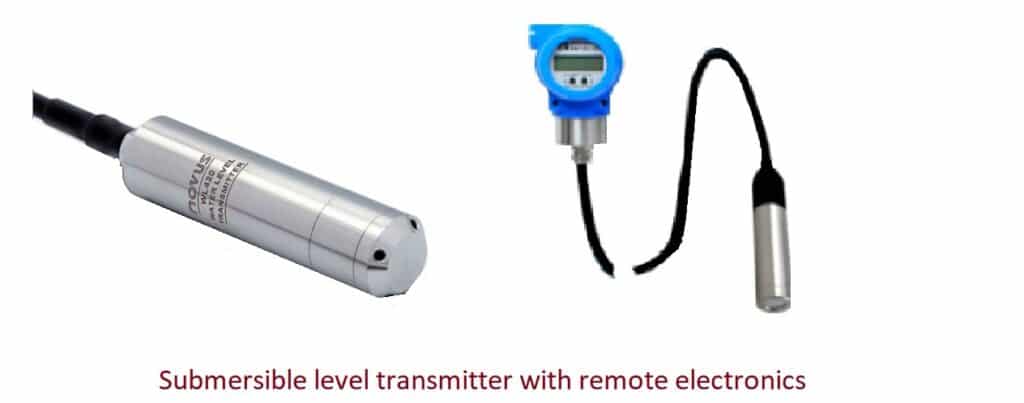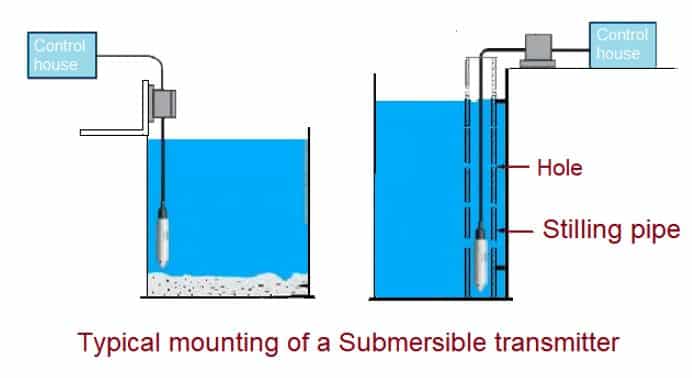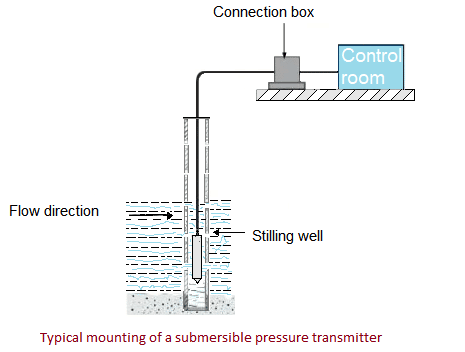A submersible level transmitter monitors the continuous liquid level in wells, reservoirs, tanks, boreholes (wells), rivers, and others.
The submersible transmitter senses the hydrostatic pressure at the bottom of the liquid. Further, the transmitter converts the hydrostatic pressure into a 4-20 mA current signal. This 4-20 mA current signal is proportional to the water column. Finally, the transmitter transmits the current signal to the upstream indicator, or in the control room.
It is possible to measure pressure and level both with submersible transmitters. The low pressure and high-pressure units are mbar(millibar) and Bar respectively.
Construction of Submersible level transmitter
It has a highly stable 316L stainless steel diaphragm with special construction. The diaphragm has its attachment to the piezo-resistive sensor. The piezo-resistive sensor is fully compatible with most semi-aggressive liquids and oils.

The sensor part of the transmitter submerges into the liquid. The transmitter has its mounting at a safe working place with a flange or bracket.
A submersible level transmitter has a special cable designed to vented to equalize changes in atmospheric pressure. The cable accurately transmits the measured liquid level, cable length depends on the application and the desired extension.
The submersible level transmitter features stainless steel construction, flange installation, local display, and calibration. It has an optional ATEX explosion-proof version for applications in hazardous environments.
We can measure the height from the end of the water level transmitter to the water surface by placing it directly into the container or body of water. And, thus the water level signal(4-20mA) must be transmitted after temperature compensation & linearity correction.
Working Principle
The submersible liquid level transmitter working is on the principle that the static pressure on the sensor is proportional to the height of the liquid. Thus, by measuring pressure on the sensor, it is possible to measure the level of liquid.
The submersible level transmitter is connected to a cable, immersed in the bottom of a tank or well. The sensor works by measuring the hydrostatic pressure of the liquid.
On placing the liquid level sensor at a certain depth in the liquid, the pressure on the front face of the sensor is;
Ρ = ρ. g. H + Po
Where:
P = Pressure applied on the face of the transmitter
ρ = Density of the measured liquid
g = Acceleration of gravity
Po = Atmospheric pressure on the surface of the liquid
H = the depth of the transmitter in the liquid
Hydrostatic pressure or head pressure is the pressure exerted by the liquid content in the tank or well. The density and the height of the liquid are the two parameters that affect the hydrostatic pressure measured by the submersible level transmitter.
The sensors must compensate for the atmospheric pressure that acts on the fluid surface because these instruments are measuring the hydro-static pressure.
At the same time, the pressure of the liquid is introduced into the positive pressure cavity of the sensor through the gas conductive stainless steel.
The atmospheric pressure Po on the surface of the liquid is connected to the negative pressure cavity of the sensor to compensate for the Po at the back of the sensor. Therefore, the pressure on the submersible sensor is ρ.g.H.
Installation of the Sensor
Installation in the static liquid
The below figure shows the installation method used in the case of static liquid.

It is recommended that the installation of the submersible level transmitter is away from liquid resources. This is to avoid the effects of vibration and pressure influence. A stilling well is recommended for the best results.
Installation of submersible pressure transmitter in the flow

The transmitter has a high-precision silicon piezo-resistive pressure sensor as the sensing element. It is capable of continuously detecting and measuring the liquid level with high precision.
Submersible level transmitters have various pressure ranges from mbar to bar. They are often used with a SCADA, PLC, or compatible display/control system for liquid level indication or control.
Operation
The pressure at the bottom of the tank is directly related to the height of the liquid column. This pressure is called head pressure or hydrostatic pressure. Typical units for measuring hydrostatic pressure are inches, feet, or meters of the water column. Modern PLCs and HMIs can calculate the liquid level of a tank by inputting the geometry of the tank and the specific gravity of the liquid.
INSTALLATION
This section covers installation and commissioning instructions. The installation of the device must be carried out by trained personnel, qualified specialists authorized to perform such work.
CAUTION
The transmitter power supply should not be turned on while installing it. May cause injury to operating personnel.

Avoiding sand or mud from accumulating on the sensor probe is required for better measurements. Otherwise, the transmitter would be damaged. The above image shows the durable cage design, which is a protection for the sensing unit from floating objects.
Considerations to take before installation
Before installation, make sure that:
- The static pressure produced by the liquid at the installation site does not exceed the Full-Scale range of the transmitter.
- The measurement liquid is compatible with the transmitter material of construction.
- While mounting the transmitter, avoid areas subject to electrical noise, excessive vibration, and radiant heat.
Installation methods
- Insert the transmitter vertically downwards into the measurement container.
- Make sure the transmitter is completely submerged in the liquid for the best accuracy.
- Ensure that the measurement liquid is compatible with the transmitter’s material of construction.
- Make sure that the holes in the protection cap are not blocked by particles suspended in the measurement liquid.
- Installation in the static liquid
- Stilling well tube is used to avoid disturbance to the sensing part for both static and flowing liquids.
Advantages
- Submersible level, pressure transmitter provides a highly reliable, accurate measurement platform.
- It can be dropped into smaller boreholes, helpful for groundwater level measurement.
- Installation is quite flexible and easy to use.
- Sensor parts withstand all kinds of vibration and shocks.
- Its size is small and weight is very less.
- Precision measurements.
Applications
Submersible level transmitter is widely used for liquid measurement and control of petroleum, chemical industry, power station, city water supply and drainage, and hydrology.
Read Next: